The family of anti-personnel fragmentation mines POM-2 "Edema"
As POM-1, "Anti-personnel fragmentation mine, the second" was developed by the Research Engineering Institute. This time, Soviet specialists did not take into account foreign experience, but used their own ideas and built a project solely on them. The new project planned to create a promising anti-personnel mine with sufficient power, as well as the possibility of installation on different surfaces using remote mining systems. In addition, it was planned to remove parts from the equipment, due to which the previous POM-1 had a limited service life.
Mina POM-2 "Edema" is intended for installation using automated systems, which affected the composition of its equipment and layout. In the transport position, this product is located inside a special metal cup with a set of parts for proper descent to the ground and subsequent installation. In the transport position, the mine has a diameter of the order of 6,5 cm and a height of about 18 cm. The total weight of the product is 1,6 kg. The dimensions and weight of the Edema mine were determined in accordance with the requirements of existing remote mining systems.
The ejection device glass is a cylinder open at one end, in which there is a pyrotechnic ejector and a brake parachute stabilizer. The latter is a metal base with six kapron ribbons 440 mm long. The task of the stabilizer is to brake the mine when it falls, and also to ensure the correct position when falling on the ground. The glass is also equipped with two separate lids.
Inside the glass is the mine itself. It has a cylindrical body of lesser height, equipped with an explosive charge, a fuse and an installation device. The latter consists of six spring-loaded legs, made in the form of curved plates with perforations. When released from the glass, they decompose and lead the mine body to a vertical position, ensuring optimal distribution of the fragments when the main charge is detonated.
The body of the mine is a fragmentation shirt, when crushing which produces a large number of damaging elements. In the upper part of the body there is a fuse and target sensors with their ejection system. As part of the latter there is a special unit to be shot, as well as four anchors with threads.
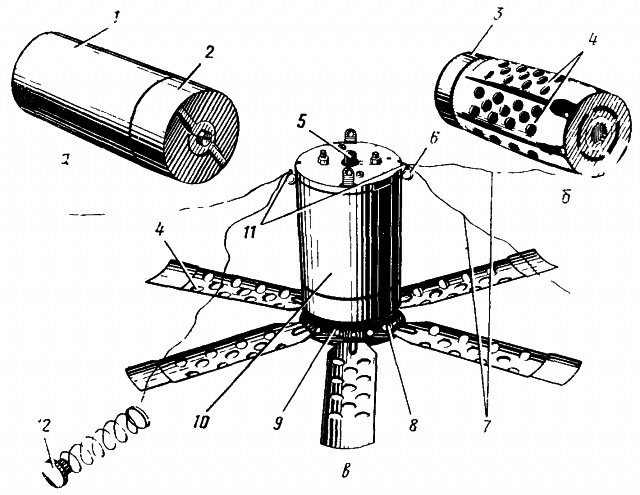
POM-2 mine scheme. Top glass (left) and mine without him (right). In the center - mine in a combat position. Figure Saperka.ru
An important feature of POM-2 mines is the architecture of the fuse and self-destruct. In their design there are no electrical components, so that the shelf life and combat work, in comparison with POM-1, increase several times. The VP-09C fuse has a mechanical design, the self-destruct is hydromechanical. Both of these mechanisms can work stably under different conditions, although some of their parameters directly depend on the surrounding conditions.
Having a relatively small size, the mine POM-2 is equipped with a charge of weight 140 g and surpasses its predecessor in this parameter. This fact, as well as other design features provide superiority and other characteristics, as well as overall combat effectiveness.
The Edema anti-personnel mines of the first version were not intended for manual installation. Minefield creation using this weapons produced using cassettes and appropriate triggering devices. POM-2 mines are placed in KPOM-2 cassettes, four in each. Cassettes, in turn, can be loaded into launchers aviation (VSM-1) or land-based (UZM) remote mining systems. These devices are responsible for the release of mines with their subsequent installation.
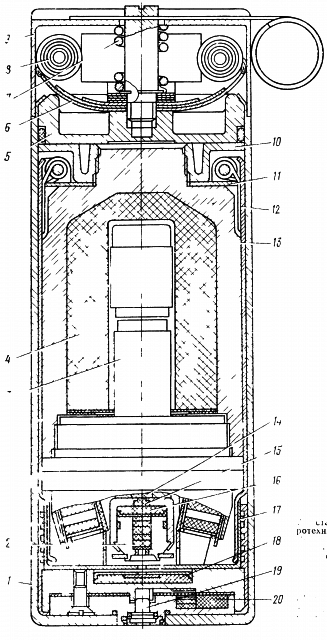
Mine cut. Figure Saperka.ru
The parameters of a minefield set with the help of remote mining tools depend on a number of factors, primarily on the number of cassettes and the speed of movement of the minelayer. Thus, a minelayer of the type UMZ on a wheeled chassis, equipped with special launchers, is able to install a minefield with a length along the front up to 5 km with a depth of up to 60-140 m. At the same time, it is possible to install a two-lane field. The creation of such a barrier takes 720 min type edema.
A helicopter or a landlayer emit POM-2 mines in the KPOM-2 cassette. At a given height, the cassette opens and throws mines. Immediately after leaving the cassette, the glass of the mine drops one of the lids, which leads to the release of the ribbon stabilizer. Six kapron ribbons ensure the mines descend along a trajectory close to the vertical, and also reduce the speed of its fall. According to available data, the Edema product maintains its performance when falling on the ground at speeds up to 60 m / s.
With the help of a stabilizer mine falls to the ground and is in a vertical or horizontal position. In the event of a fall, a pyrotechnic moderator ignites, which “counts” 50 from and gives the command to reset the glass. Separate powder expelling charge pushes a mine from a glass and throws them away from each other. When this occurs, the ignition of the second moderator, which is designed for 3-4 with. After it burns out, the mine drops another lid, as a result of which the feet of the installation device are released.
Under the action of the springs, the legs open and occupy a horizontal position, raising the mine body in a vertical position. In this position, the mine remains until the moment of operation or self-destruction. Through 1,5-2, after lifting to a vertical position, target target anchors are shot. For this, the powder charge ejects a special block of complex shape, on which four anchors are fixed. Climbing up on 0,5 m above the mine, the unit shoots and scatters anchors that stretch 10-meter threads.
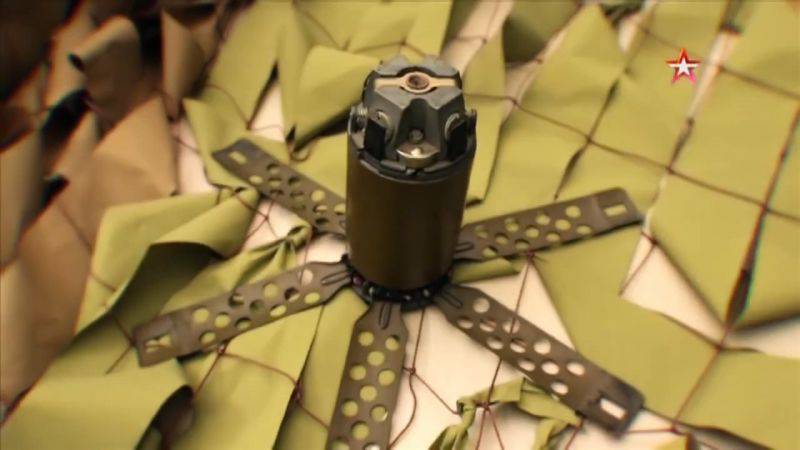
Layout mines, imitating weapons in the process of cocking. So, the block of anchors is not reset yet. Frame from "Military Acceptance" channel "Star"
The threads at one end are connected to the anchors. Their other ends are mounted on two fuse pins that perform the function of a target sensor. When tensioning one of the threads with a force of the order of 0,3 kg, the probe pin shifts, after which the fuse detonates the main charge. Under the impact of the energy of the explosion, the body of the mine is crushed into a large number of fragments, ensuring a continuous defeat of manpower within a radius of 6-8 m (according to other data, up to 15-16 m).
Mina POM-2 is equipped with a hydromechanical self-destruction mechanism, which, depending on the surrounding conditions, provides self-sabotage in the interval from 4 to 100 hours from the moment of installation. The countdown to elimination begins after the scatter of anchors with threads.
POM-2 "Edema" anti-personnel mines have a fairly high efficiency and are superior to the previous POM-1 in this parameter. Effective application is provided due to the increased charge and the optimized form of the case splitting into fragments. The cylindrical shape of the hull, in contrast to the spherical, directs most of the fragments away from the mine, and the number of destructive elements falling into the ground or flying vertically upwards is significantly reduced.
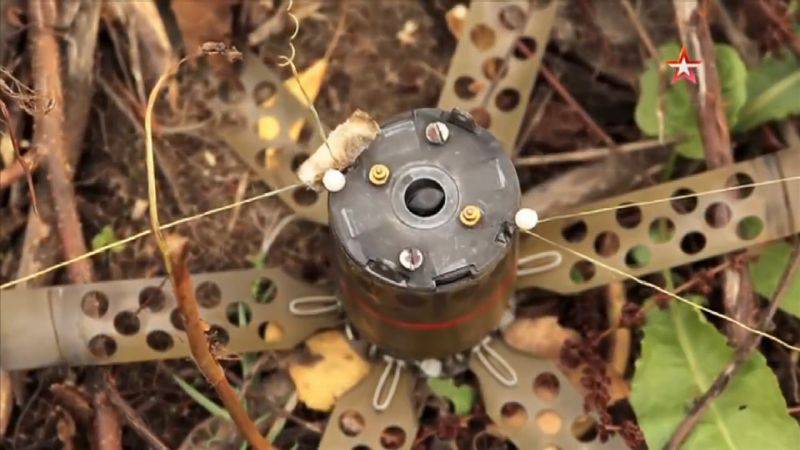
The head of the training mines in the combat position. Frame from "Military Acceptance" channel "Star"
In the design of the "Oteka" there are no devices that impede the disposal of these weapons, however, the mine is considered to be non-neutralizable. Detection of such a munition is extremely difficult, especially given the fact that mines are placed in groups on large sections of the terrain. During installation, mines are scattered in different directions the threads of the target sensor with high sensitivity. The threads form a dense network, and can also intertwine with each other, which is why movement along a minefield becomes impossible: any careless step can lead to the disruption of at least one mine. In addition, in some situations it is not excluded the simultaneous detonation of several ammunition, which leads to an increase in the affected area.
Due to the sensitive sensor of the target and long threads, minefield clearance based on POM-2 mines is possible only with the use of elongated charges or by repeated travel on armored vehicles with an appropriate level of protection. Mine clearance by other means is inappropriate or deadly.
One of the main differences of POM-2 mines from the previous POM-1 is the absence of any sources of electrical energy and electrical components. All processes of preparation for work and undermining are carried out at the expense of powder charges, tension energy of threads, etc. Due to this, the edema warranty period of storage of mines reaches 10 years - twice as much as POM-1 has in ideal conditions. Recall that POM-1 was required to be stored under certain conditions, in particular, a warm storage room was required. Otherwise, the self-discharge of batteries could be accelerated, reducing the shelf life of ammunition.
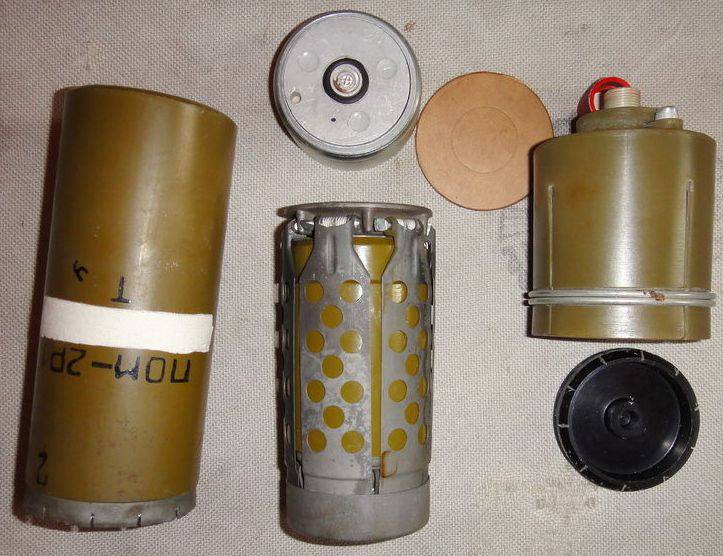
Mina POM-2P in parsing. From left to right: glass, lids (above), mine and URP device. Photo Sniper-weapon.ru
In the nineties, a new modification of the Edema mine was developed called POM-2Р. The letter "P" means "Manual." The main objective of the new project was to ensure the installation of mines manually. This method of installation is not very efficient, but in some cases, a mine of POM-2 with similar capabilities may be useful for solving some specific tasks, primarily for organizing small minefields, for example, along the line of enemy fighters.
Mina POM-2P is a slightly revised POM-2. The main difference is the absence of a stabilizer and the design of the glass, modified accordingly. In addition, the "manual" mine should be used in conjunction with a special device URP, ensuring its installation without the use of automated tools.
The product URP is a plastic cup with four slots on the walls, on the bottom of which there is a school mechanism. The design of the latter provides a primer-igniter, a drummer, a mainspring and some other details.
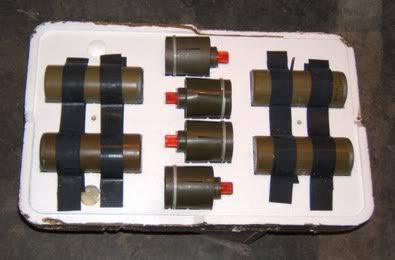
The location of the "manual" mines and the URP in the capping. Photo by Grossfater-m.livejournal.com
Before installing the POM-2P mines, you should put the EWS device on it. For the best fixing on the plastic case the metal ring is provided. After that, the cap nut is removed and the nylon thread is pulled out, then the mine is placed in the right place. The position of the mine does not matter, since it is equipped with an installation device. If necessary, POM-2Р mines with the EWS devices can be installed on the move or from a moving vehicle. In this case, they can simply throw on the ground after removing the thread. All other operations for preparation for work are carried out automatically.
Removing the thread leads to the unblocking of the drummer, which hits the primer-igniter cap and starts the mechanisms of mine laying. After the corresponding moderator burns out, the mines are shot from the glass and the URP device is reset. After that, the mine spreads the legs, rises in a vertical position and scatters the target sensor threads. In this regard, POM-2 and POM-2Р are not different from each other.
"Manual" mines are supplied in foam capping, each of which contains four ammunition and the same number of URP devices. In this form, the weapon is referred to as the "Anti-personnel set of manual mining KRM-P."
The POM-2P anti-personnel mine can be produced in several versions with different characteristics. Thus, the POM-2P1 product is distinguished by its increased to 120 with the time of its transition into a combat position, and POM-2РBS and POM-2РХNUMXБС are versions of POM-1Р and POM-2Р2 without self-destructing. At the same time, the preparation time for work corresponds to the basic modifications.
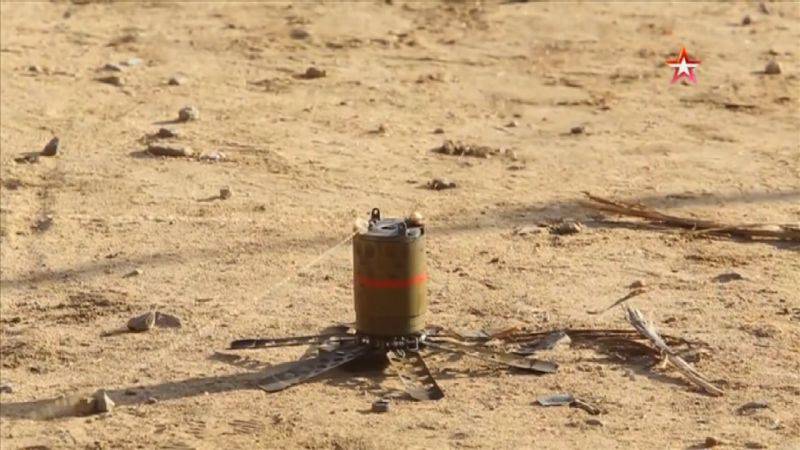
Mina on the position. The four threads of the target sensor are visible. Frame from "Military Acceptance" channel "Star"
Within the framework of the “Edema” family, several training mines with different composition of components were created. Product UI-POM-2-1 differs from a mine in the absence of a primer-detonator and detonator. Mina UI-POM-2-2 has pyrotechnic elements, but is not equipped with a main charge, and UI-POM-2-3 instead of TNT carries a smoke charge and has holes in the body. Such an ammunition reports about its triggering with thick smoke.
A practical product UI-POM-2Р, a mine with a smoke charge UI-POM-2РД and an inert UI-POM-2РДП with elements of pyrotechnics are offered for training in the use of "manual" mines. For obvious reasons, all training modifications are not equipped with a self-liquidator.
Anti-personnel fragmentation mines of the POM-2 family over the past few decades are in service with the Russian army and are actively used by engineers. This weapon is rated as one of the best domestic systems in its class, since it differs favorably from its predecessors by its ease of installation and high combat qualities. In addition, there are a number of critical advantages over POM-1 mine, similar to POM-2 with some features.
According to some reports, POM-2 mines still remain in mass production and are being delivered to the troops. Simultaneously, the Research Institute of Engineering is working on the development of anti-personnel weapons. Not so long ago it became known about the existence of a new project POM-3 "Medallion", which uses some of the developments on the "Edema". Moreover, the development of mine weapons continues. In the foreseeable future, new models of such weapons with even higher characteristics should appear.
On the materials of the sites:
http://saper.etel.ru/
http://eragun.org/
http://saperka.ru/
http://sniper-weapon.ru/
http://grossfater-m.livejournal.com/
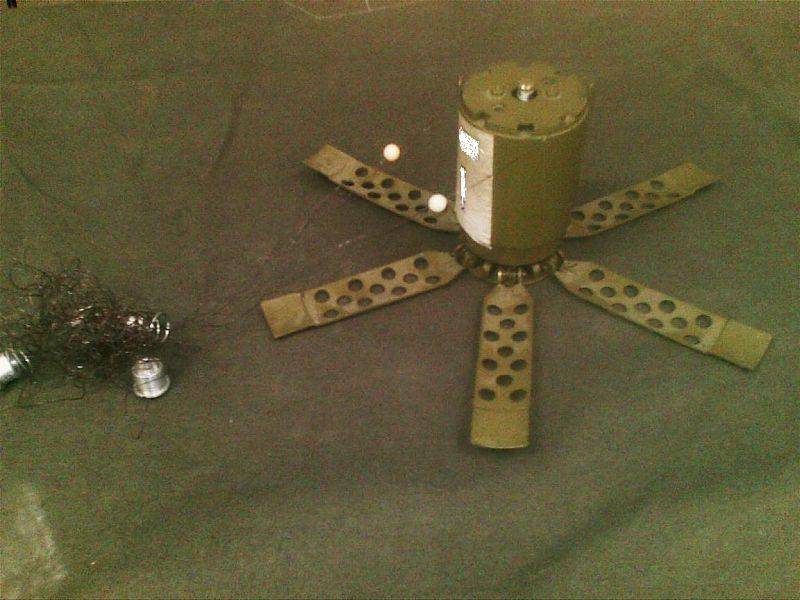
Information